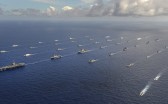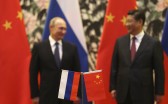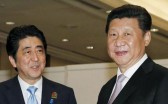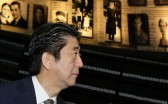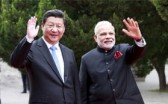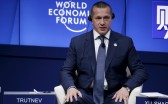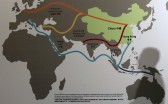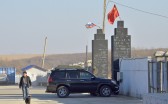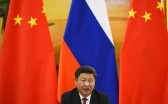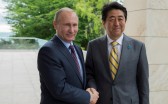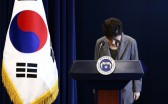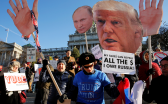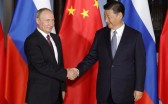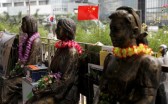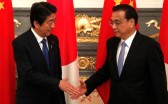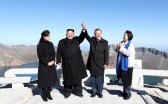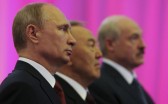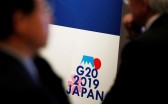Alexander Lukin, in his Positive Scenario 1, writes that “the course to transform Russia into an independent Eurasian center of power and world influence has today become the official policy of the Kremlin and the main direction of thought of the majority of Russian experts on foreign policy strategy.” In my first essay I took quite a broad approach and now have little to add, while finding that Lukin is extremely optimistic when he talks of a “boost to the Shanghai Cooperation Organization” and the possibility of “a division of labor between the Eurasian Economic Union and the Silk Road Economic Belt or, more broadly, the Greater Eurasian project and the Belt and Road Initiative.” In this essay I focus on Lukin’s argument that “Russia’s military might is fully in keeping” with its Eurasian ambitions, “but its economic development still noticeably falls short.” That is, they are dragging each other down. In my view, Russia’s “military might” and “economic development” are related, with efforts to boost the former presently adversely affecting the latter, and vice versa. Concentrating on the “military force” aspect of “warfare,” I do not look at military doctrine or strategy but consider the effect on military capabilities of broader technology and economic issues, as well as the interplay between the two, arguing that Russia is likely to remain comparatively weak in military technology and economics unless it adjusts many of its policy settings.
Russia is depending heavily on its military to establish itself as an independent center in Eurasia. Given the relative weakness of the militaries in most neighboring states, its predominance is secure. Yet, with the US and NATO presence to the west, China and strong US alliances to the east, and rising military competition further to the south, the prospects of Russia relying on its military clout to exert autonomous power are likely to be clouded. Weakness in economic power, apart from energy exports, reverberated in the military arena. In need of military partnerships to keep up-to-date in the rapidly shifting technologies needed for the best weaponry, Russia is poised to be left behind.
How real is Russia’s “military might” and how sustainable is it? Earlier this year, General Valerii Gerasimov, chief of the Russian General Staff said: “As new realms of warfare appear, the methods used in contemporary conflicts are more and more often shifting toward fusion of political, economic, informational, and other non-military measures, backed by military force.”1 Gerasimov added: “Nevertheless, the main content of military strategy is the preparation for war and its conduct, first and foremost using the Armed Forces.” Russia can presently mobilize a very large number of armored vehicles, which could be used in the Central Asian part of the Eurasian land-mass, although the focus is on its Western periphery.2 Since the conflict with Georgia in 2008, Russia’s ground combat capabilities have particularly benefited from reorganization, updated weapons, and investments in electronic warfare.3 Russia can also use its air force to bomb weakly defended targets in a larger geographical area, and does have some powerful technically advanced offensive and defensive weapons.
Nevertheless, according to Aleksandr Golts, “the legacy of the Soviet Union is still very much present in the modern Russian army, as many of its cutting-edge systems are the development of good, old Soviet systems and the modernization of that type of technology.”4
Having visited quite a few Russian companies (including factories) in the early/mid-1990s, I took the view in 2001 that one of the main reasons for the collapse of the Soviet Union was that “the industrially centrally managed economy was struggling to cope with the move toward advanced electronics, services (and “information”) activities. The gigantic factory approach of Russian central planners, workable for an earlier simpler age, was incapable of taking the Russian economy further.”5 It had trouble taking advantage of the Third Industrial Revolution, when production moved from “logic and functioning,” generally “directly observable and understandable,” to the information age in which so much is unseen.6
According to Gustav C. Gressel, the 1990s “provided a window of opportunity for the defense industry to catch up in sectors where the Soviet industry traditionally lagged behind. The computing revolution increased the availability of commercially available hardware, allowing Russia to modernise legacy systems with advanced electronics, sensors, and communication equipment. This has been the core of Russia’s modernisation efforts of the last two decades.”7 Indian analysts also believe that Russia, even to now, has maintained very significant defense technology proficiency in metallurgy.8 Upgrading existing major hardware platforms with continuously improving bits and pieces is, of course, not exclusively a Russian issue. The US B52 bomber produced in the 1950s is still in service and continues to be upgraded, perhaps for several more decades.9
The more general problem for Russia is that modern weapons systems (along with technology generally) are rapidly growing in complexity. Russia lacks both a diverse commercial technology base and ready access to foreign technology that could support the production of domestic high-tech modern weapons. One indication of this is the very low level of complex manufactured products in its exports, with “high-tech” export items rare.10 This is more than just a function of Russia’s so-called “resources curse,” as a country rich in resources such as Australia still manages to have a reasonably sized high-tech export sector (with much of it based on the SME sector).
US analysts say that its “defense leaders are increasingly aware that the impetus for innovation for much of the next generation of military equipment, both hardware and software, will come from the commercial sector and that this sector is increasingly globalized. This is particularly true with respect to information technologies, software development, artificial intelligence, robotics, and the biological sciences."11 Thus, the US is working to increase its access to and ability to use technologies being driven by the commercial sector,12 and the Chinese are doing the same. However, it must be conceded here that there is some debate on just exactly how important such a commercial industrial base really is, and this may arguably be relevant to Russia.
Andrea Gilli and Mauro Gilli (writing mainly about China’s efforts to imitate and steal foreign military technology) argue that modern weapons systems continue to become so complex13 that simply possessing a generally high-standard commercial industrial and technology base is less sufficient than in the past for achieving specialized military innovation and production because of the many special requirements of the latter.14
They say that “defense and civilian industries have come to differ dramatically, to the point that even realms such as defense and commercial shipbuilding or aviation have limited opportunities for synergy,” and that “even the defense and commercial divisions of companies like Boeing enjoy limited opportunities for synergies.”15
Yet, they also point out that the Aegis anti-missile defense system, “one of the most advanced military technologies of the U.S. Navy,” which was “fielded in 1983” – and which “remains unrivalled in the world” – “relies on dual-use technology for more than 75 percent of its components.”16 Whatever the exact situation with individual military items, the Gillis persuasively argue that a solid commercial industrial and technology base is not sufficient for modern military innovation and production. Yet, even if there may not be horizontal synergies, there will be many common vertical roots. It is unrealistic to think that all such technological development occurs only in military factories and defense research centers. A lot of it, including the basic development of a broader labor force skilled enough for selected workers to be moved into specialized military production, will depend directly or indirectly on developments in the supply chains for production of consumer and other industrial goods. Many of the best students entering technical universities will not be attracted to the production of military goods and services—just ask Google about Project Maven17 and its response to AI18—but their commercial work will help build a country’s technology base, and ultimately military production capability. Even if the use of dual-technologies is as limited as the Gillis suggest, some of these innovations will then be further developed for specific military application.
It is unclear how future technology developments, particularly those associated with the so-called Fourth Industrial Revolution, will affect Russia, but some signs are not good. For example, according to a recent report by FOI, the Swedish Defense Research Agency, Russian machine tool builders “have so far overlooked the on-going paradigm shift, where especially high-end machine tool companies are transforming from being merely manufacturers to becoming ‘process solution partners’ that are more or less integrated into their customer’s entire business and manufacturing processes.”19 For
Andrey Kolganov, there is now only experimental production of “industrial robots.”20 Of course, this does not mean that the Russian military in uninterested in robots. In early 2019 Gerasimov said that “the next direction of research is related to the large-scale of military robotic systems, starting with UAVs, to contribute to a wide range of missions.” It, instead, may mean that there is insufficient appreciation in the Russian security-defense establishment of the role of commercial activities contributing to military capabilities.
Writing in early 2017, Andrey Frolov said that "if the sanctions against Russia persist for a long time, the Russian defense industry may again seek full autarky, which would have a negative impact on its innovative potential in the long term."21 Frolov, in a late 2017 ISS report, says that “one of the main problems with import substitution is the lack of a modern machinery base for the production of goods to replace those previously acquired from abroad,” adding that “this is emerging as one of the most important issues, especially under the current restrictions on obtaining new machine tools suitable for the production of military products and dual-use goods.”22
Fearing the effects of continued foreign sanctions, the Russian government has attempted to be pro-active and promote domestic production of machine tools. The FOI report says that “the government’s efforts to ban foreign-made machine tools in military-related production have turned out to be futile” as “most defense companies have either chosen to deliberately circumvent the import ban or to abstain from their planned capital investments.” The latter response obviously has long-term consequences that will often remain hidden in the short-term. The report adds that it “seems highly likely that production within Russia’s strategic industries – particularly within the defense industry – will rely, by and large, on foreign machine tools well into the 2030s.”23 Moreover, most imports are at the high-tech end of the machine tool market where, as notes by the Gillis, technical specifications for defense product output tend to be extremely precise.
Gressel says that the increasing cost and complexity of weapons is leading “medium sized powers” (such as France) to co-operate more with other countries. “But,” he says, “that is not the Russian way. So far Russia is prioritising independence over efficiency. Given the nature of the Kremlin’s foreign policy and its reluctance to engage in deepened cooperation with other states, Russia has failed to build a permanent and structural partnership with any other international player.”24
In contrast, the US approach seems to be that "a 21st century” defense industrial base must be “international.” According to Daniel Goure, “the pace of globalization in the aerospace and defense industry is quickening. In part, this reflects the great expense involved in many large aerospace programs" and "in part, this also reflects the reality that many foreign countries, particularly US allies in Europe and Asia, now possess critical design skills, production capabilities, and products."25 In the case of the F-35 Joint Strike Fighter, according to Goure, “eight foreign allies are part of the consortium to develop and build the aircraft," although in some cases, international politics rather than technical capacity may be a major consideration. For example, according to F-35 program manager Vice Adm. Mathias Winter around 6 or 7 percent of parts are made in Turkey.26
Still, the international open source nature of much advanced software27 means that Russia’s defense industries will always have an international input. So, in the final analysis, is Putin’s emphasis in an early 2018 speech to Russia’s Federal Assembly, on a limited number of powerful hypersonic nuclear and a few super-punch weapons a sign of strength or weakness? Some Russian policy makers seem to see such talk as a sign of strength. Former foreign minister Igor Ivanov said that Putin was really offering an “olive branch” and wanted to get the US to negotiate.28 But given the overall assertive Russian foreign policy stance outside of Eurasia and the present US perception of Russia, the reality is that it is likely to have the opposite effect.
Here it should be noted that Gerasimov, when talking about the “new types of weapons,” says that “sufficient numbers will be deployed to ensure deterrence” and that "there is no doubt we are clear leaders in this field when compared to technologically advanced countries.”29 But, as Andrea Gilli and Mauro Gilli note, “the history of military innovation is, in the end, the history of innovation, counter-innovation, and further innovation.”30 Or, between better swords and better shields. It may be that technology is at such a stage that the shield has permanently lost the battle, but the US is clearly not prepared to accept this as it explores the possibility of using laser and micro-wave shields against hypersonic missiles.31 If the US cannot quickly develop such shields, it is likely to take advantage of the relative size of its economy, and simply produce more swords than Russia, more hypersonic weapons aimed to take-out Russian launch pads as soon as possible.32 China, despite present good relations with Russia, is likely to react in the same way as the US. Gerasimov’s confidence that the “new types of weapons” will “allow Russia not to be drawn into an arm’s race” is very optimistic.33 Moreover, Russia is hardly likely to use such weapons in defense of another Eurasian country, so they do little to increase its attractiveness as a Eurasian pole.
Alexander Lukin writes that “on the basis of its political and military prowess, Russia is having partial success in being recognized as an autonomous pole in Eurasia.” Despite some claims that Russia can be a “security provider,” it is hard to think of any Eurasian country that might view Russia in this way. China fully intends to be its own security provider, although it will be grateful if Russia can play a role in helping keep things quiet in Russia’s Central Asian backyard. Other Eurasian countries should not expect support from Russia in any disputes with China. Lukin wrote that “coverage of Russia’s economy is beyond the scope of this scenario,” but then he often refers to Russia’s actual and prospective economic performance. All he adds is that “the economic system of today’s Russia, to a large degree, corresponds to the Eurasian ideal,” where “all transformative historical reforms were done with the help of the state, which played the most active role in the economy.”
There is considerable truth in this statement when it comes to the initial industrial development of Japan, South Korea, and China, and it is also the case that defense requirements were the basis for or pushed the development of many modern-day technologies. But, as noted earlier there is evidence of “radical change” with general technology innovation often outpacing military innovations in many areas.34 Another view is that Russia should concentrate on taking greater advantage of its natural resource base similar to what Australia has done to maximize is total economic output and wealth; the reasons for this view are in my 2016 report on Russia’s National Technology Initiative.35
However, such a strategy is most effective if a country also has ready access to advanced foreign technology (and labor skills), which it can adapt to its own specific circumstances, and if the country can be acceptably integrated into international production supply chains.
The rapid advance of 5G illustrates Russia’s predicament.36 The hardware (and associated software) is so complex that pulling it apart and understanding it in order to ensure that it has no malicious capability is leading some countries to ban or severely restrict the use of Huawei products. (This is similar to the situation that the Gillis note with Chinese attempts to imitate US military technology.) Russian “state”-led efforts – corresponding to Lukin’s “Eurasian ideal” – to develop a complete domestic 5G production (hardware and software) capacity would only lead to a second or third-rate product. China might be able to become self-sufficient in 5G because of the size of its market and its extensive manufacturing base, but the Russian funds, arguably, can be better allocated to take advantage of its natural resources.
This does not mean that Russia should not aim to develop an advanced military-technology sector. What is does mean is that excessive efforts in this direction – particularly the “full autarky” mentioned by Andrey Frolov – will have an adverse effect on Russia’s total wealth creation and, in the final analysis, on Russia’s ability to spend money to defend itself in a sensible and measured way. Taking the machine tools example further: “Is Russia prepared to cultivate sufficiently good relations with the West to get what it needs in high-end machine tools, or will it make do with what it can find from wherever it can get it? Either of those choices might in their own way deny Russia from meeting its long-term geostrategic goals.”37
Foreign sanctions on Russia and Russia’s own pride in its self-sufficiency are ultimately negative factors for both its total military prowess and its total economy. A more balanced policy approach is needed if Russia realistically wants to be an “independent Eurasian center of power and world influence.” This does not mean that Russia should surrender its national security interests. Even if the annexation of Crimea could be justified, given the actual and professed expansionist ideas of NATO, instead of logically offering some form of apology and compensation after the event, Russia clearly supported Ukraine separatist forces with extensive military support.
This great emotion with its mainly Soviet Union historical roots is Russia’s Achilles’ heel, and one of the reasons it cannot be a pole in Eurasia. Most of Eurasia was never part of the USSR, but the present Russian leadership cannot accept this fact nor the possibility that it may have been different. Apart from the technology and natural resource aspects, the best way for Russia to have a stronger economy is to concentrate on building the rule of law and honest institutions. I first wrote about this in 1992 when, after my second visit to Russia, I said that there was “too little emphasis on the need for rapid and vital reforms in the accounting, banking and legal spheres, including anti-monopoly legislation” and it “is almost as if this very important component of an effective market economic system will rise by itself.”38 Russia has been making progress in some areas, but very little in others. A recent AT Kearney report on “Russia’s readiness for the Fourth Industrial Revolution” concludes that Russia’s “economy risks becoming less competitive over time if it does not make major improvements to its institutional framework, its technology and innovation.”39
Conclusion
Russia’s “military might” is not “fully in keeping” with its ambitions to be “an independent Eurasian center of power and world influence,” and many of its official policies aimed at achieving this “military might” are adversely affecting its “economic development.” This, in turn, ultimately adversely affects “military might.” Russia’s present policy involves escalating the weapons in which it still retains a credible threat, but which is destabilizing for Eurasia more than confirming Russia as a steadfast partner. This present policy also increases the possibility of Russia falling under China’s influence as it seeks Chinese technology to help boost its own military efforts aimed at the West. While the option of reconciling with the West is least likely under Russia’s present leadership, longer-term fear of China and Russia’s natural European orientation will eventually – if war can be avoided in the meantime – bring it about.
1. General Valerii Gerasimov, "Vectors of Development of Russian Military Strategy in Current Conditions," South Front, March 14, 2019, https://southfront.org/vectors-of-development-of-russian-military-strategy-in-current-conditions/
2. Charles Dick, "Russian Ground Forces Posture Towards the West," Chatham House, April 2019,
https://www.chathamhouse.org/sites/default/files/publications/research/2019-04-04-Dick.pdf
3. Daniel Gouré, "Winning Future Wars: Modernization and a 21st Century Defense Industrial Base,” The Heritage Foundation, October 4, 2018,
https://www.heritage.org/military-strength/topical-essays/winning-future-wars-modernization-and-21st-century-defense
4. Darko Janjevic, "The strengths and weaknesses of Russia’s military," DW, April 7, 2018, https://www.dw.com/en/the-strengths-and-weaknesses-of-russias-military/a-43293017
5. Jeff Schubert, "US National Missile Defense (NMD), or ‘mini-Star Wars,’” Speech to Australian Institute of International Affairs (Sydney Branch), March, 5, 2001 http://www.jeffschubert.com/index.php?id=57
6. Andrea Gilli and Mauro Gilli, "Why China Has Not Caught Up Yet: Military-Technological Superiority and the Limits of Imitation, Reverse Engineering, and Cyber Espionage," International Security, Vol. 43, No. 3 (Winter 2018/19), pp.141-89,
https://www.mitpressjournals.org/doi/full/10.1162/isec_a_00337
7. Gustav C. Gressel, "Strategy and Challenges,” in Richard A. Bitzinger and Nicu Popescu, eds., "Defense Industries in Russia and China: players and strategies," Institute for Security Studies, November 2017,
https://www.iss.europa.eu/sites/default/files/EUISSFiles/Report_38_Defense-industries-in-Russia-and-China.pdf
8. Ashish Puntambekar, "Re-imagining India’s Defense Industry Base Crystal Ball: The Two New Defense Industrial Corridors," India Foundation Journal, September-October 2018, http://indiafoundation.in/wp-content/uploads/2018/09/September-October-2018-India-Foundation-Journal.pdf
9. Daniel Gouré, "Winning Future Wars.”
10. International Trade Centre’s “Trade Map,” http://www.trademap.org/countrymap/Bilateral_TS.aspx
11. Daniel Gouré, "Winning Future Wars.”
12. “Countries promote military civil integration and investing in ‘dual use technologies’ to foster military innovation,” International Defense, Security and Technology, December 31, 2018,
https://idstch.com/home5/international-defense-security-an,d-technology/industry/countries-investing-in-dual-use-technologies-to-foster-military-innovation/
13. They write that “in the 1930s, a combat aircraft consisted of hundreds of components, a figure that surged into the tens of thousands in the 1950s and to 300,000 in the 2010s. As the number of components expands, the number of potential incompatibilities and vulnerabilities increases geometrically. Ensuring the proper functioning and mutual compatibility of all the components and of the whole system thus becomes increasingly difficult.”
14. Andrea Gilli and Mauro Gilli, "Why China Has Not Caught Up Yet.”
15. Andrea Gilli and Mauro Gilli, "Military Technology: The Realities of Imitation," CSS Analysis in Security Policy, No. 238, February 2019, http://www.css.ethz.ch/content/dam/ethz/special-interest/gess/cis/center-for-securities-studies/pdfs/CSSAnalyse238-EN.pdf
16. Ibid.
17. Kate Conger, "Google Plans Not to Renew Its Contract for Project Maven, a Controversial Pentagon Drone AI Imaging Program," Gizmodo, June 1, 2018,
https://gizmodo.com/google-plans-not-to-renew-its-contract-for-project-mave-1826488620
18. Sundar Pichai, "AI at Google: our principles," Google, June 7, 2018, https://www.blog.google/technology/ai/ai-principles/
19. Tomas Malmlöf, "The Russian machine tool industry: Prospects for a turnaround?" Swedish Defense Research Agency, February 2019.
20. Андрей Колганов, "Ни станков, ни роботов: зависимость РФ от импорта достигла от 60% до 90%," Regnum, March 22, 2019, https://regnum.ru/news/economy/2596727.html
21. Andrei Frolov, "Russian in Place of Foreign," Russia in Global Affairs, February 13, 2017, https://eng.globalaffairs.ru/number/Russian-in-Place-of-Foreign-18590
22. Andrey Frolov, “Defense Technologies and Industrial Base,” in Richard A. Bitzinger and Nicu Popescu, eds, "Defense Industries in Russia and China.”
23. Tomas Malmlöf, "The Russian machine tool industry.”
24. Gustav C. Gressel, "Strategy and Challenges.”
25. Daniel Gouré, "Winning Future Wars.”
26. Paul McLeary, "F-35 Production Hurt If Turkey Kicked Out of Program: Vice Adm. Winter," Breaking Defense, April 4, 2019,
https://breakingdefense.com/2019/04/f-35-production-hurt-if-turkey-kicked-out-of-program-vice-adm-winter/?utm_campaign=Breaking%20News&utm_source=hs_email&utm_medium=email&utm_content=71482421&_hsenc=p2ANqtz-9waQT7uJzVy6UaXeUAQqmUNW_g1Crxoi_Snvxh34nM7E3QIGcomSt6NpnKffioopKid9zMamDdjH3AbxaEIBk9aJk_An7P9bLfliwAjvHMeOWwAtU&_hsmi=71482421
27. Michael Griffin, Under Secretary of Defense for Research and Engineering, Statement before Sub-Committee of US Senate Armed Services Committee, April 18, 2018, https://www.armed-services.senate.gov/imo/media/doc/Griffin_04-18-18.pdf
28. Igor Ivanov, "Russia Is Offering an Olive Branch, Not Flaunting Nuclear Weapons," RIAC, March 6, 2018,
https://russiancouncil.ru/en/analytics-and-comments/analytics/russia-is-offering-an-olive-branch-not-flaunting-nuclear-weapons/
29. General Valerii Gerasimov, "Vectors of Development of Russian Military Strategy in Current Conditions."
30. Andrea Gilli and Mauro Gilli, "Why China Has Not Caught Up Yet.”
31. Sydney J. Freedberg Jr., "Lasers, Hypersonics, & AI: Mike Griffin’s Killer Combo," Breaking Defense, March 20, 2019, https://breakingdefense.com/2019/03/lasers-hypersonics-ai-mike-griffins-killer-combo/
32. Colin Clark, "Tackling Hypersonic Threats: Offense Or Missile Defense?" Breaking Defense, March 11, 2019, https://breakingdefense.com/2019/03/tackling-hypersonic-threats-offense-or-missile-defense/
33. General Valerii Gerasimov, "Vectors of Development of Russian Military Strategy in Current Conditions."
34. “Countries promote military civil integration and investing in ‘dual use technologies’ to foster military innovation,” International Defense, Security and Technology, December 31, 2018,
https://idstch.com/home5/international-defense-security-and-technology/industry/countries-investing-in-dual-use-technologies-to-foster-military-innovation/
35. Jeff Schubert, “National Technology Initiative – ‘Waiting for High-Tech Tooth-Fairy!’” Russian Economic Reform, June 30, 2016, http://russianeconomicreform.ru/2016/06/russian-national-technology-initiative-failure-or-success/
36. Jeff Schubert, "Russia’s Huawei 5G Conundrum," RIAC, February 11, 2019, http://russiancouncil.ru/en/analytics-and-comments/columns/cybercolumn/russia-s-huawei-5g-conundrum/
37. Tomas Malmlöf, "The Russian machine tool industry.”
38. Jeff Schubert, ““Russian Reformers and the IMF Get It Wrong,” HSBC Australia report, April/May 1992. Republished in Russian Economic Reform, http://russianeconomicreform.ru/
39. “Preparing Russia for the Future of Production,” AT Kearney,
https://www.atkearney.com/documents/20152/1285683/Preparing+Russia+for+the+Future+of+Production.pdf/ac555d2e-67f7-1874-eaa4-fd999ae0b84a
